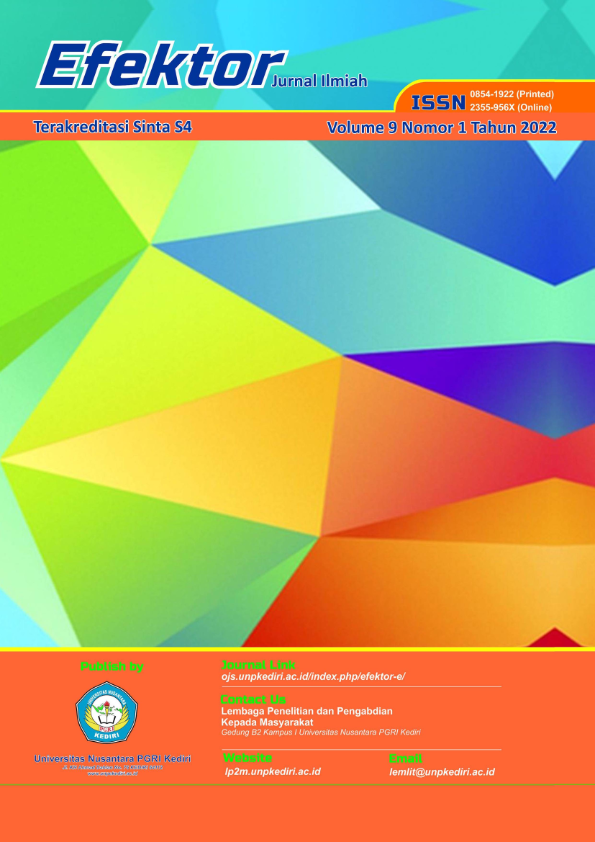Studi Tentang Candi Ngetos Di Kabupaten Nganjuk Ditinjau Dari Kajian Ikonografi
DOI:
https://doi.org/10.29407/e.v9i1.17516Keywords:
ngetos, candi majapahit, nganjuk, jawa timurAbstract
Study About Ngetos Temple in Nganjuk Regency, Research, Historical Education, FKIP UNP Kediri.
In Indonesia many historical relics have a very extraordinary value, the temple is the result of the nation's culture that is high in value. The existence of a temple is not yet known to the wider community. Such conditions are caused by the lack of written sources about the history of the temple building. We all certainly realize that the temple building is a potential asset of the nation in various aspects of development. One of the temples that is not yet known to the wider community is Ngetos Temple. The author deliberately raised Ngetos Temple as a research object whose purpose was to study and uncover the existence of Ngetos Temple in Ngetos Village, Ngetos subdistrict, Nganjuk Regency. Ngetos area is indeed suitable for a monumental sacred building that is located in a mountainous area and allows for the development of tourist attractions of the Nganjuk regency. The results of Majapahit culture have also been studied by the Dutch East Indies government under the leadership of Governor-General Thomas Stanford Raffles since 1817. The building of Ngetos temple as a result of Majapahit culture serves as a place of worship of ancestral spirits and worship of the gods.
References
Budiono, E. M. A., Soepeno, B., & Nirmala P, R. P. (2019). Nilai Edukasi Candi Jabung Kecamatan Paiton Kabupaten Probolinggo dalam Pembelajaran Sejarah. SINDANG: Jurnal Pendidikan Sejarah Dan Kajian Sejarah, 1(2), 23–27. https://doi.org/10.31540/sdg.v1i2.278
Depdikbud. Tim Penyusun kamus Pusat Pembinaan dan Pengembangan Bahasa. (1989). “Kamus Besar bahasa Indonesia”. Jakarta : Balai Pustaka.
Fauzi, N. B., & Rahmawati, F. E. (2018). Ikonografi Sebagai Langkah Kerja Kreatif Cipta Sastra Anak Dari Relief Candi. Hasta Wiyata, 1(1), 15–21. https://doi.org/10.21776/ub.hastawiyata.2018.001.01.02
Hoeve Van Bare, (1980). “Ensiklopedi Indonesia”. Jakarta
Hadi Sutisno, (1989). “Metodologi Research II”. Yogyakarta : Andi Offset.
Harimintadji. (1995). Nganjuk dan Sejarahnya. Nganjuk :Daerah Tingkat II Nganjuk.
Irawan, A., & Idris, M. (2018). Seni Perhiasan Dalam Kebudayaan Mataram Kuno Sebagai Sumber Pembelajaran Sejarah (Studi Ikonografi Relief Candi Borobudur). Kalpataru: Jurnal Sejarah Dan Pembelajaran Sejarah, 3(1), 11. https://doi.org/10.31851/kalpataru.v3i1.1606
Kaningtyas, M. J. (2016). Kaitan Latar Belakang Pendidikan Guru ter-hadap Pemanfaatan Candi Kotes sebagai Sumber Belajar. Sejarah Dan Budaya : Jurnal Sejarah, Budaya, Dan Pengajarannya, 10(1), 63–71. https://doi.org/10.17977/um020v10i12016p063
Koentjaraningrat, (1987). “Kebudayaan Mentalitas dan pembangunan”. Jakarta : Gramedia.
Muljana Slamet. (1953). “Negara Kertagama dan Tafsir Sejarahnya”. Jakarta : Bhatara Karya Aksara.
N.J. Kroom. (1956). “Zaman hindu”. Jakarta : PT. Pembanguanan.
Notosusanto Nugroho, (1968). “Sejarah dan hankam”.Jakarta : Dephankam.
---------, 1983. “Sejarah nasional II”. Jakarta : Balai pustaka
Ngadiono, (2003). Peninggalan Sejarah dan Kepurbakalaan Candi Penataran. Dinas Pendidikan & Kebudayaan Propinsi Jawa Timur. Surabaya : Perintis Grapic Art.
Pemda Dati II Nganjuk, (1980). “ Sejarah Kabupaten Madiun”. Madiun.
Poesponegoro, Marwati Djoened. & Nugroho Noto Susanto. (2012). Sejarah Nasional Indonesia .Jakarta : Balai Pustaka.
Soekmono,R (1974). “candi, Fungsi dan Pengertiannya”. Jakarta : UI.
Downloads
Published
Issue
Section
License
Authors who publish with this journal agree to the following terms:
- Copyright on any article is retained by the author(s).
- The author grants the journal, the right of first publication with the work simultaneously licensed under a Creative Commons Attribution License that allows others to share the work with an acknowledgment of the work’s authorship and initial publication in this journal.
- Authors are able to enter into separate, additional contractual arrangements for the non-exclusive distribution of the journal’s published version of the work (e.g., post it to an institutional repository or publish it in a book), with an acknowledgment of its initial publication in this journal.
- Authors are permitted and encouraged to post their work online (e.g., in institutional repositories or on their website) prior to and during the submission process, as it can lead to productive exchanges, as well as earlier and greater citation of published work.
- The article and any associated published material is distributed under the Creative Commons Attribution-ShareAlike 4.0 International License













